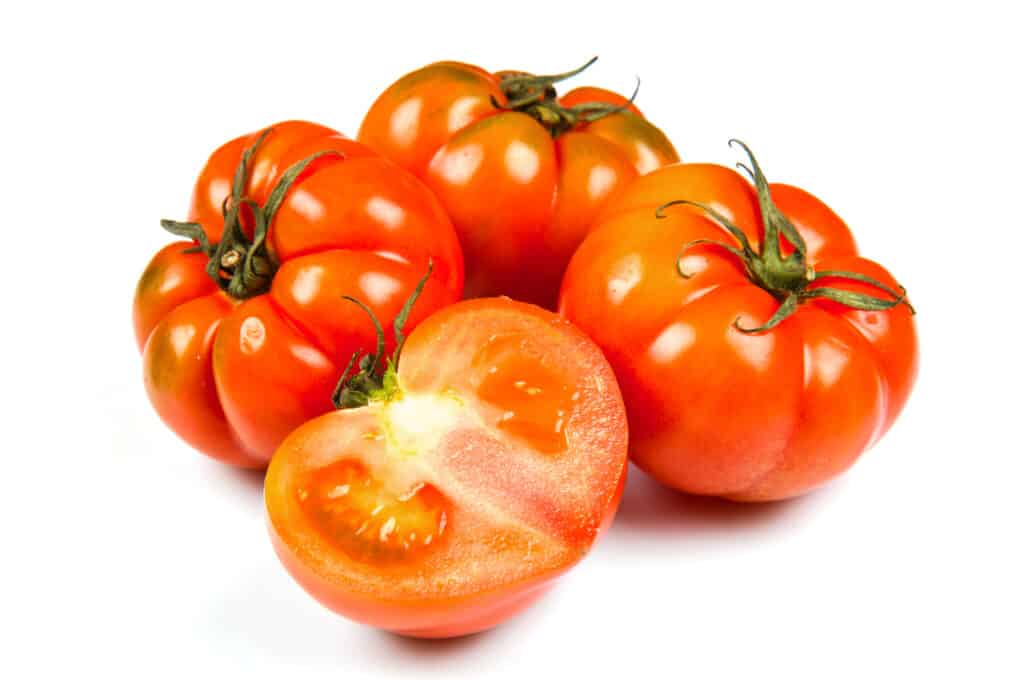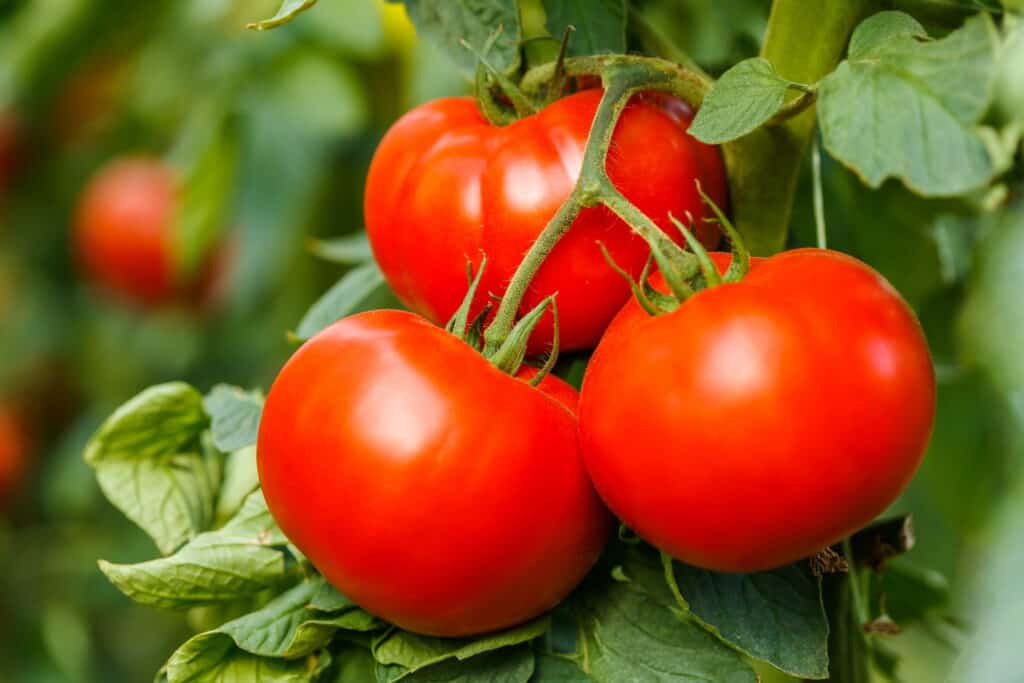With thousands of varieties available, tomatoes are a wonderfully adaptable fruit. You can choose huge meaty varieties that can cover an entire sandwich while remaining sweet and delicately fragrant or tiny tomato cherries that, when first ripe, offer a pleasant sour crunch.
The beefsteak tomato and the big boy tomato are two of the most popular tomatoes. These big beefy tomato varieties are perfect for planting in your garden, especially if you love putting thick, flavorful tomato slices on your sandwiches. While these large-fruiting tomato varieties are similar, they are also different in some crucial ways. Let’s look at these two varieties and explain why they’re great to plant together in the same garden.
Comparing Big Boy Tomato vs. Beefsteak Tomato
Key Differences Between Big Boy Tomato vs. Beefsteak Tomato
Lycopersicon Lycopersicum, also known as solanum Lycopersicum, is the plant that produces the delicious, juicy berries (yes, they are technically berries) known as tomatoes. The big boy tomato and the beefsteak tomato are two of the vast varieties of tomato that are grown today. More than 10,000 tomato varieties are currently available, with more being produced daily.
The big boy tomato and beefsteak tomato are pretty similar. They can be grown with similar spacing, sun exposure, and water needs. Since they are vining tomatoes, their growth is indeterminate, meaning they do not abruptly stop growing after a particular stage in the plant’s development. They can usually be harvested simultaneously, at around 78 to 80 days.
While the big boy tomato and beefsteak tomato are similar, some key differences are worth knowing before attempting to grow them on your own. Firstly, beefsteak tomato plants can yield fruits weighing, on average, a whopping 16 ounces. Some beefsteaks have weighed in at four pounds or even more. These are the beefiest of tomato fruits.
Big boy tomatoes, while large, usually can yield around nine ounces per fruit. Big boy tomatoes are ideal for salads and juicing, while beefsteak tomatoes are better for slicing for sandwiches and chopping up for salsa and hot sauces. The big boy tomato is a hybrid variety, while the beefsteak tomato is an heirloom variety.
Big Boy Tomato vs. Beefsteak Tomato: Classification

Luca Santilli/Shutterstock.com
All tomatoes are classified as Lycopersicon Lycopersicum or solanum Lycopersicum. Big boy tomatoes and beefsteak tomatoes are two varieties of this plant. Types of tomatoes can vary significantly, and these two varieties are some of the largest tomato varieties.
Big Boy Tomato vs. Beefsteak Tomato: Description
The big boy tomato boasts robust plants that produce abundant, crimson tomatoes. With firm, smooth, red fruit and a long history as a best seller, Burpee’s large boy tomato offers superb flavor and top-notch quality. It became popular immediately after its 1949 introduction thanks to its astounding size and attractive scarlet color. Big boy tomatoes are well-known among chefs and food enthusiasts for their sweetness and melt-in-your-mouth juiciness. This variety can easily weigh up to nine ounces when grown properly.
The meaty, juicy tomatoes known as beefsteaks are excellent for summertime sandwiches or sliced nibbles with a dash of sea salt. This late-maturing tomato variety will produce a plentiful harvest in about 85 days after growing to a height of around six feet. The biggest beefsteak tomatoes can weigh one pound or more. It needs a strong cage, trellis, or stake to support its fruit.
Big Boy Tomato vs. Beefsteak Tomato: Uses
Both of these tomato varieties are used in cooking, but each has particular culinary uses. Big boy and other larger slicing tomatoes are used in grilled vegetables, stews, casseroles, and sauces, in addition to being wonderful when eaten raw in a salad or sandwich. Big Boy tomatoes can also be dried, canned, or frozen.
The beefsteak differentiates itself by its size and solid, meaty feel in the culinary world. Fresh beefsteak tomatoes are typically served sliced, frequently on sandwiches or in other dishes calling for sliced tomatoes. They are, however, also perfect for creating flavorful salsas and fiery sauces.
Big Boy Tomato vs. Beefsteak Tomato: Origin And How To Grow

Szasz-Fabian Jozsef/Shutterstock.com
The seed and plant store Burpee invented and pioneered the big boy tomato. On the other hand, the beefsteak tomato has a much older history. Scientists believe that the first wild type of tomato plant brought over to Europe from Mexico and Central America by the conquistadors in the early 1500s was the beefsteak. Today, beefsteak remains a popular tomato variety for cooking.
Tomatoes are generally grown using the same methods, regardless of the variety, with a few minor exceptions. The big boy and beefsteak tomatoes thrive in gardens with vining structures to hold their enormous, heavy fruits off the ground. Use cages and poles to support the plant’s growth. Always use a large pot and position the tomato plant in full sunlight. Keep an eye on your watering because plants in containers dry out more rapidly than those in the ground.
Optimal Growth Methods
Plant rows of tomatoes in the ground around two or three feet apart. There should be four feet between each row. When planting, placing them closer together is tempting, but doing so will raise the risk of illness. When planting, use a slow-release fertilizer.
Dig a hole almost twice as wide as your pot in a sunny position that receives six hours or more of direct sunlight daily. You can remove the plant from the pot by breaking up the soil and tipping it out into your hand. Plant your tomatoes deep in the ground, up to the top two leaf nodes. Your plant will stabilize in the soil if the tiny hairs on the stalk develop into new roots. To hold your plant firmly in the ground, add more soil to the surrounding area and lightly compact it.
If additional soil is required to level it out with the rest of your garden, add it immediately to help the earth settle. To support the plants and keep the fruit off the ground, where it can rot, you’ll need wire tomato cages or stakes.
Big Boy Tomato vs. Beefsteak Tomato: Protections and Conservation
Many different varieties of tomatoes grow around the world. They are hearty plants that can grow in many different climates, from agricultural zones five through eight. Tomatoes are thus not considered a protected species under any government and are not listed as endangered or at risk of becoming extinct.
Big Boy Tomato vs. Beefsteak Tomato: Special Features
Beefsteak tomatoes are among the most substantial tomatoes and are perfect for sandwiches and burgers because they are juicy, meaty, and flavorful. The characteristics of beefsteak tomatoes include their enormous size, meaty texture, traditional tomato flavor with a hint of sweetness, high weight, and rich red-orange hue. The largest of all tomato kinds is the beefsteak, which is thick and fleshy. This variety has many sub-varieties, including the pink beefsteak, bucking bronco, beefmaster, brandywine, and more. Although beefsteaks typically have a smooth structure, some sub-varieties may have ribs.
The big boy tomato is a sizable, red slicer cultivar with a harmonious sweet-tart flavor. The first widely used hybrid tomato was actually the big boy variety, created by Burpee Seeds in Pennsylvania. Late in the tomato season, these F1 hybrid tomatoes start to ripen. The large boy tomato is a hybrid variety; the seeds cannot be preserved or handed down. Burpee must hybridize fresh seeds from this variety each year to produce this particular fruit.
The big boy and beefsteak tomatoes are complimentary tomatoes that grow well together. If you can’t choose between the beefiness of the beefsteak and the fragrant, fresh taste of the big boy, why not plant them together? You’ll be able to yield some massive tomatoes by the end of the year with either of these excellent tomato varieties.
Up Next:
- Celebrity Tomato vs Early Girl Tomato
- Grape Tomato vs Cherry Tomato: Is There a Difference?
- Will Cicadas Eat My Tomato Plants?
The post Big Boy Tomato vs. Beefsteak Tomato appeared first on AZ Animals.
from Animal News, Facts, Rankings, and More! - AZ Animals https://ift.tt/9dz1MoJ